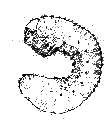Beetles
What is a Beetle, What is not a Beetle?
What is a Beetle?
The scientific name for the beetle group, Coleoptera, means 'sheath winged'. This refers to their most important characteristic - forewings which have become hardened coverings known as elytra. These protect the folded hindwings when they are not in use. The elytra are not completely v useless when the beetle flies, but are often turned to point forwards and upwards, probably acting like aeroplane wings to give the beetle some lift.
Compared with many soft and vulnerable insects, the beetle is a well-armoured tank. Its hard but flexible shell (cuticle), the structure of which has been likened to fibre-glass, protects it well from predators and from infection by microorganisms, as well as against physical accident. An additional wax layer helps prevent water loss. With this tough construction, it is perhaps not surprising that these insects have become the most successful of all animal groups.  The majority of beetle larvae, on the other hand, are fat, soft and caterpillarlike, with or without legs The majority of beetle larvae, on the other hand, are fat, soft and caterpillarlike, with or without legs
When the larva ready to pupate it stops feeding and may leave the food source. Some simply tunnel under stones, but leaf and stem feeders often drop on to the soil and burrow beneath the surface. Some ground beetles burrow down for a matter of metres - but wood borers may head for the surface so that, as adults, they are able to escape easily. Water beetle larvae usually leave the water and burrow into nearby soil. The larvae hollow out a chamber in which to pupate, perhaps lining it with a type of faecal cement. Some produce a cocoon but this is rare in beetles. (Script Source: Environmental Protection Agency. illustrations: Insects of Australia courtesy CSIRO) Return to Rainforest Insects Page |
What is not a Beetle?
| Cockroaches are not beetles:
Although the toughened forewings of flying species are somewhat similar, they overlap instead of meeting in a straight line. | 
| Bugs are not beetles:
Beetles tend to have chewing mouthparts while those of bugs are adapted for sucking. | 
| Earwigs are not beetles:
They have forceps-like structures at the tips of their abdomens. Some rove beetles, with reduced wing covers and forceps-like mouthparts, can superficially resemble earwigs. | 
| | Cockroaches, bugs and earwigs all develop their adult form gradually, developing wings (unless they are wingless species) during the last few moults. Beetles (like butterflies, bees and flies) start as larvae and after a period of pupation, emerge as fully formed adults. | (Script Source: Environmental Protection Agency. illustrations: Insects of Australia courtesy CSIRO) Return to Rainforest Insects Page
|
Defense Strategies of Beetles.
Defense strategies This rufous and black beetle is toxic - and is mimicked by numerous other non-toxic beetle species (and a moth) which copy its warning colours.
Beetles produce a variety of chemicals to protect them from their enemies from bacteria and fungi as well as predators which may be tempted to make a meal of them. One of these chemicals is cantharidin, found in large quantities in the infamous 'Spanish fly', a beetle of southern Europe. Although poisonous, cantharidin has been used medicinally - and as an aphrodisiac. | 
| (Script Source: Environmental Protection Agency. illustrations: Insects of Australia courtesy CSIRO) Return to Rainforest Insects Page |
Some Beetles Co-exist in Other Insect Colonies.
Life in the colonies
A number of beetle species live inside the colonies of termites, ants and bees for at least part of their lives. They are tolerated and even fed and protected by their hosts, some of them paying in the form of a food secreted from special glands - an arrangement somewhat similar to the relationship between certain caterpillars and ants. Other beetles are less friendly, living next to ant colonies and picking off the inhabitants for dinner, or raiding their food stores. Another set of beetle larvae prey on bees. The adult female lays eggs on flowers. The young larvae then attach themselves to visiting bees to hitch a lift back to the nest. There they feed on the bee larvae as well as on the honey and nectar stores. Some beetles have become honorary termites. Having taken on the appearance of termites, they are treated as colony members. (Script Source: Environmental Protection Agency.) Return to Rainforest Insects Page |
The Role of Beetles in Recycling Rainforest Nutrient.
The importance of the living dead
Although a dead tree, in a living forest, is viewed as a loss of life, nothing could be further from the truth. The decaying wood is seething with life as insects, together with fungi, work on breaking it down. These insects - termed saproxylic contribute to the health of forests and their inhabitants in many ways: - They recycle the nutrients once gathered by the trees, eventually making them accessible to the next generation of forest growth.
- By converting wood into protein (themselves) in both adult and larval forms they provide food for numerous birds and other animals.
- They provide homes. Around the world, woodpeckers play an important role in creating holes in trees but in Australia, a continent with more holenesting birds and mammals than anywhere else, there are none of these wood-drilling birds. Our possums and parrots would have great difficulty excavating their nest and den holes if it were not for wood-boring insects.
To maintain numbers of these useful creatures, their habitat - 'overmature' trees and dead logs - needs to be protected. Studies in temperate forests have shown that logged forests have significantly fewer saproxylic insects than less disturbed forests, because trees have been removed before they are old enough to produce dead wood. Without noticing, Europeans were losing these insects to the point where a disproportionately high number of them now feature on the this endangered lists. Little is known of how logging has affected saproxylic insects in tropical forests. However, Rainforest CRC researcher, Simon Grove, is keen to redress the balance. He is currently studying the saproxylic insects - specifically beetles, the main group - which munch on dead wood in the lowland Daintree rainforests. To date Simon has collected 450 different species but anticipates finding many more. He hopes to discover whether there are differences between what beetles are found in logged and unlogged areas of the Wet Tropics. His ultimate aim is to work out a standard, or indicator, which forest managers could use to measure sustainable rainforest management. Rather than looking at large animals, when evaluating whether a logging operation is causing long-term harm to a forest system, it may be more useful to look at the amount or variety of dead wood or overmature trees which would be needed to sustain the myriad insects that live there. The greatest loss of biodiversity is probably at the micro level - but these little creatures are no less important for being small. Instead, they are a vital part of the whole. | (Script Source: Environmental Protection Agency.) Return to Rainforest Insects Page |
|
